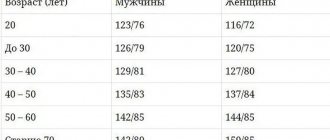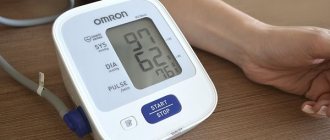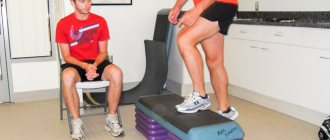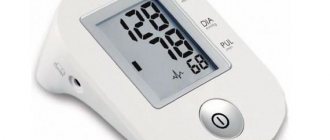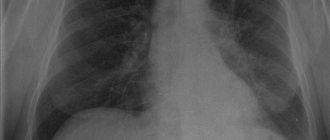Why does the tonometer show the pressure incorrectly?
Tonometers are special medical devices that measure blood or eye pressure. In the latter case, the device is called a pneumotonometer. Such devices are an indispensable attribute of doctors. However, today blood pressure measuring devices are successfully used at home by many people, especially those suffering from hypertension and heart disease. A tonometer is even recommended for them, because patients must always keep their blood pressure under control in order to avoid complications caused by increased blood pressure. Tonometer readings are recorded as two measurements, for example, 120/80 mm Hg. Art. What do these numbers mean? This is the different pressure created in each of the two phases of the heart. The first reading is the highest blood pressure pumped by the heart. In our example, it is 120 - it is called systolic. The second reading is minimal. It is observed in diastole, when the heart relaxes, fills with blood, and then pushes it out. This “lower” pressure is referred to as diastolic.
Pulse pressure
Such an important parameter as pulse pressure deserves special attention. This indicator determines the difference between systole and diastole. Its normal value varies from 35 to 45 (mmHg). But these numbers also change throughout life, especially when the body is exposed to various factors.
Thus, pulse pressure parameters can increase under the influence of such unfavorable factors as:
- pathology of the thyroid gland,
- the development of atherosclerotic changes in arteries and small vessels caused by the aging process of these structures,
- with diabetes mellitus.
A decrease in pulse pressure is most often a consequence of pathological processes in the kidneys or adrenal glands. In these organs, renin is synthesized, a component that makes vascular tissue more elastic. When normal kidney function is disrupted, excess renin is released into the bloodstream. Then the vessels are no longer able to resist the onslaught of blood flow. Diagnosing such a deviation in practice is quite difficult.
Tonometer shows different pressure
There are situations when tonometers show different pressures. This may be due to the characteristics of the device itself, the time of day, and its readings also strongly depend on its incorrect use or non-compliance with the instructions. For example, for any person after a walk in the fresh air, the blood pressure monitor will show higher pressure than after 5 or 10 minutes of rest. This is normal, even doctors suggest that the patient sit quietly before measuring blood pressure. If you take measurements several times in a row, the tonometer may show different pressures. This is due to the fact that after the first check, the vessel walls compressed by the device did not have time to recover, and blood flow is still difficult. In this regard, it is recommended to re-measure only after 3 – 5 minutes. It should be borne in mind that some people, especially the elderly, need 10 to 15 minutes to restore blood vessels. Very often people ask why there is a difference in values between the measurements of an electronic and mechanical tonometer. On the first, they are 15 - 20 mm Hg higher. Art. even with parallel blood pressure measurements. This is explained simply: the electronic device is too sensitive to many changes.
Arteries and pressure measurement methods
Arteries are vessels through which blood moves from the heart to the organs. The main task of the arteries is to carry blood coming from the heart under a certain pressure. To fulfill this purpose, arteries have a special structure.
The wall of an arterial vessel consists of three layers
:
- Endothelium or inner layer (controls blood clotting components);
- Middle shell. Consists of muscle and elastic fibers. Muscle fibers correct blood pressure by vasoconstriction (narrowing the lumen of the vessel) and vasodilation (expansion of the lumen of the vessel). Elastic fibers create conditions for the propagation of a pressure wave (pulse wave);
- Adventitial layer (attaches the vessel to adjacent tissues).
The force with which blood presses against the walls of blood vessels is called blood pressure.
This indicator can be measured in different parts of the cardiovascular system; therefore, the following types of pressure are distinguished:
- capillary;
- intracardiac;
- arterial;
- venous;
- central arterial and venous.
When the tonometer stopped showing pressure
Blood pressure (BP) is of particular diagnostic value. With a simple measurement technique, it fully characterizes the current state of human health and allows you to respond in a timely manner to all negative changes.
Nowadays, blood pressure is measured in two main ways.
:
- Invasive method;
- Non-invasive methods.
The automatic tonometer responds to the following factors:
third-party interference, even air movement;
muscle tension, imperceptible movement of the arm or body; emotional condition. The sensitive sensor even reacts to air movement. You must behave calmly, not talk, keep your back straight. The tonometer cuff attached to the arm should be at the level of the heart. If you remove all interference and follow the instructions, the result will be correct. If you need to get a more accurate result, you can take measurements three times with the necessary break between them. After this, it is important to derive the arithmetic average. We must remember: the first indicator and the last may differ due to the artery getting used to compression or any involuntary movement, so triple measurements will provide more accurate data. We must remember that a decrease, as well as an increase in pressure beyond the normal range, is an alarm signal. It is necessary to find out the cause by contacting a cardiologist. Very often, tonometers may not produce results at all or show incorrect results, as well as show different pressures for various technical reasons: they forgot to insert the batteries; the device is not used correctly; low-quality batteries that quickly fail. In order for electronic blood pressure monitors to work well, it is necessary to change the batteries on time. It is advisable to use only ALKALINE LR batteries for blood pressure monitors. They are more energy-intensive and guarantee a long service life, which is from 200 to 400 measurement cycles. Here, the word cycle means 2 – 3 times a day. Regardless of the manufacturer, LR batteries will ensure the operation of the tonometer for 4 – 6 months. When the tonometer is turned on, the display is tested, and if the device shows a symbol that indicates insufficient power, this means that the batteries are running low - it’s time to take care of new batteries. In addition to errors associated with measuring blood pressure with a device and technical reasons, different pressures can be completely physiological. It is worth remembering that active movements, stress, even sneezing and coughing increase blood pressure. This is a natural reaction and does not require medication. Blood pressure increases for a short time, and if you repeat the measurements a little later, the values will decrease significantly. When purchasing a tonometer for home use, be sure to carefully study the operating instructions for this device. If used incorrectly, errors may occur, for example, when the tonometer does not show pressure. Understanding the cause of the malfunction is quite simple if you know the features of measuring pressure with a specific device.
If the tonometer shows different values, it is too early to sound the alarm and blame the device for lying, since the person himself may carry out the measurement incorrectly. The most common reasons for changing values when repeating pressure measurements are:
- incorrect installation of the cuff;
- arrhythmia;
- dead tonometer batteries;
- incorrect body position.
Most often the cause is incorrect installation of the cuff. This is not typical for shoulder tonometers, although changes in readings may be observed when the cuff slips. This is due to changes in arterial compression.
This problem is more typical for wrist tonometers. The narrow cuff should be placed strictly above the radial artery. If it is moved, rotated, or loosely installed, a performance problem will occur.
Electronic tonometers, regardless of type, can show different values for arrhythmia. There is only one way to correct the situation - by replacing the device with a device equipped with an arrhythmia indicator. In this case, the device will take a series of measurements and display the average value. In the case of arrhythmia, small discrepancies of 2-3 mmHg are not an error and should not raise concerns about a device malfunction.
In approximately half of the cases where an error occurs, the reason is quite banal - a low battery charge. This problem is typical only for devices that are powered by AA batteries. In the budget segment, mobile automatic blood pressure monitors are often not equipped with a charge indicator, and the battery life is calculated based on the number of measurements.
To avoid failures due to low battery charge, it is better to buy a mains-powered tonometer
Incorrect body position greatly affects the measurement results. Traditionally, blood pressure is measured while sitting. In this case, the arm on which the cuff is installed should be strictly at the level of the heart. This rule is the same for all tonometers - both shoulder and wrist. The electronic tonometer shows different results in different positions. Taking measurements while lying down leads to an error of about 10 mmHg. If you raise your hand above the level of your heart, the pressure will be approximately 5-7 mmHg. below. Moreover, the higher the hand is raised, the lower the indicators will be.
What do the numbers on the blood pressure monitor mean?
After measuring the pressure, numbers are displayed on the tonometer screen - indicators of pressure (upper/systological and lower/diastolic) and heart rate.
All home blood pressure monitors have the same sequence of this data, regardless of the manufacturer. Let us recall the norms of pressure and heart rate indicators with age correlation.
Heart rate - pulse
To obtain correct data, the pressure is measured three times on one arm with an interval of one minute. Some modern tonometers have the function of independently determining the average value calculated from three pressure measurements.
When measuring pressure, it is important to follow the rules:
- The wrist tonometer is worn at a distance of 1 finger from the hand.
- The Velcro strap is fixed so that there is no pinching of the hand.
- The cuff tonometer is attached to the arm at a distance of two fingers from the elbow bend so that the elastic tube passes through the center of the palmar surface of the hand;
- During the measurement, you must sit at a table - your hand should lie on a flat surface in a relaxed state, and the cuff should be at heart level.
- The cuff is secured with Velcro without squeezing or excessive loose space.
While measuring blood pressure, after pressing the button, it is forbidden to talk, move, move your arms, or clench your fists. Feet are on the floor; you cannot cross your legs.
Another part of the disease is the detachment of the cable of the LCD screens of tonometers, as a result of which segments of numbers and letters may not be displayed on the display.
To repair such a malfunction, you will have to disassemble the blood pressure meter again and repair the cable contacts. I analyzed cases of cable detachment and repair of such cases for TVs and monitors in an earlier article.
The tonometer display cables are glued using the same principle. Repair is made easier due to the nice size and pitch of the cable contacts. Repairing such cables is much easier than in TVs.
After disassembling the tonometer, you can glue the display cable back by uniform heating using a hot air gun or a soldering iron with a special attachment for repairing cables. Watch the video on this topic - very informative and interesting.
Why does the device lose performance?
If tonometers do not show pressure, but begin to reset the readings, the reason should be sought in a malfunction of the device itself or the characteristics of the patient’s health condition. In the first case, we are talking about a serious breakdown in which the device must be replaced, but not repaired.
Resetting measurement results may be due to arrhythmia. This occurs because the device cannot measure correctly due to heart rhythm disturbances. If the tonometer is equipped with an arrhythmia indicator, it is programmed at the software level to carry out a series of measurements and display average blood pressure values on the screen. Cheap models do not have such an indicator, so the device simply cannot display the results of the measurements taken. This will lead to the fact that the tonometer will not be able to show the result, it will constantly reset the received data and restart the process of pumping air into the cuff.
The answer to the question of why the tonometer does not show pressure, but resets the results, may be hidden in random movements of the hand on which the cuff is installed. In this case, the pressure of the cuff on the artery will be distributed unevenly. The device will not be able to record the exact measurement result and will simply reset it. Solving this problem is quite simple - you just need to fix your hand in one position and take a repeat measurement.
The arrhythmia indicator and battery charge indicators are visible on the device monitor
Common device failures
To understand why the tonometer shows an error, you should first carefully study the instructions. Typically, error codes are listed in a table in the operating instructions, which allows you to quickly determine the cause of the device malfunction.
Common breakdowns of home devices:
- compressor failure;
- eating disorders;
- failure in the algorithm of the oscillometric method.
If the compressor malfunctions, the tonometer will not work. In this case, a certain error may appear on the screen. If the error code is not displayed on the screen, it is very easy to figure out such a breakdown, since in this case air will not be pumped into the cuff, and it will not compress the artery. In addition to compressor failure, this problem may be associated with a kink or rupture of the hose that connects the cuff to the body of the device.
You also need to inspect the cuff and check for integrity. Unfortunately, they are short-lived, but if the cuff is torn, replacing it will not be difficult.
Power failure and battery failure are a common reason why the tonometer resets the pressure measurement results. If the device runs on batteries, you should replace them before taking it in for repair. If the problem still persists when changing batteries, the cause must be sought directly in the contacts of the device that provide power supply.
Automatic blood pressure monitors can be powered by a rechargeable battery. Such devices are usually equipped with a special charger. If such a battery fails, usually not an error occurs, but the device simply stops turning on. To solve the problem you need diagnostics. The problem may be a failure of the battery or the charger itself.
The operation of the automatic tonometer is based on the oscillometric measurement method. If there are violations in the operation of this algorithm, errors and errors occur during measurement. This can be evidenced by both a discrepancy in the measurement results and a constant reset of the indicators and the start of a new air injection cycle.
It is important to understand that some breakdowns can lead to complete failure of the tonometer, and the device will not turn on or respond to any actions. Some breakdowns can be quite successfully corrected at a service center, but the device may also not be repairable. It is difficult to understand the reasons for the malfunction of the tonometer; it is better to take the device to a specialized service center to diagnose problems. In addition, you should not forget about the warranty. If the warranty period has not yet expired, the tonometer can be replaced by contacting a service center.
Error correction
Errors may occur when using the tonometer. Some of them you can fix yourself. If this does not work for some reason, disassembling the device yourself is highly not recommended.
Firstly, without knowledge of the features of this device, you can only aggravate the situation. Secondly, after opening the tonometer and damaging the factory seals, the free warranty period of service is automatically canceled.
The table shows the most common errors and methods for eliminating them.
| Type of error | Causes | Correction Methods |
| Flashing heart sign | Heart rate too high | Remove the device from your wrist, wait 10-15 minutes, and then measure your blood pressure again. If the situation repeats, then most likely the indicators are correct. In this case, you need to consult a doctor. |
| E E Snowflake symbol | The cuff is full of air | You need to remove the device from your hand, turn it off, and then turn it on. Next, you should measure your blood pressure again. |
| E 78 Snowflake symbol | The cuff is not securely fastened or there was movement of the arm during measurement | Turn off the device, turn it on, measure blood pressure again. |
| Er 25 | The symbol “E” with any code indicates some kind of malfunction in the device. | You need to contact the service center. |
| Indicators are too low or, conversely, excessively increased | This error can occur for several reasons: |
1. The cuff is not fastened correctly.
2. The hand with the device is not at heart level.
3. There were movements or conversations during measurements.
4. The arm is overextended.
Note.
Blood pressure readings may change throughout the day. As a rule, this is not related to the operation of the device. Changes in blood pressure depend on the time of day, weather conditions, as well as the physical and moral state of a person.
Errors when using tonometers
Wondering what to do with the difference in indicators for hypertension and why the tonometer shows different pressures, many people do not pay attention to the violation of the rules for operating this device.
Discrepancies in measurements may be caused by:
- cuff that is too narrow or wide;
- incorrect installation of the cuff;
- incorrect body position when measuring pressure;
- too frequent measurements.
If the problems of choosing and installing a cuff are quite simple, the problems of too frequent measurements should be considered in more detail. Many people make the mistake of taking a series of blood pressure measurements without stopping in an attempt to get the most accurate result.
Cardiologists warn that blood pressure should be measured no more than once every 15 minutes. When re-measuring 1-2 minutes later, there may be a significant discrepancy in the results. Sometimes the difference can reach 30-40 mmHg. This is due to the fact that after the first procedure, the artery on which the cuff presses adapts to the changed conditions. With repeated compression, the data on the pressure value will be distorted due to the body’s adaptation to the air pressure in the cuff.
Why does it show arrhythmia (different results with repeated measurements)
When measurements differ, you need to check whether the actions are correct. A person can make mistakes when taking measurements. The most common reasons for different readings during measurements:
- incorrect position of the cuff;
- heart rhythm disturbance;
- insufficient battery life for measuring pressure;
- incorrect body position.
Correct installation of the cuff is important. If installed incorrectly, the degree of pressure on the arteries changes, which leads to different measurement results. This feature is typical for wrist tonometers. The narrow sleeve should be placed over the radial vein. If the cuff does not fit tightly, is displaced or rotated, the indicators will fluctuate.
Don't trust electronic devices. Electrotonometers do not take into account arrhythmia. Indicators may change with repeated measurements. To correct the situation, you need to replace the tonometer. It is better to order a device with an indicator that shows arrhythmia. The device will take several measurements sequentially and display the overall average value.
Another common reason is low battery charge. This is typical for tonometers that operate on AA batteries. Cheap devices do not have a charge indicator, which can be used to judge the degree of wear, so when the service life is exhausted, the tonometer does not display the pressure correctly.
If the body position is incorrect, the measurements will change and the tonometer will show different pressure. It is recommended to measure blood pressure while sitting. The arm with the cuff should be at heart level. The error when measuring while lying down is 10 points. If the hand is located above the level of the heart, the readings will be 7-10 units lower than the real ones.
Correct installation of the cuff is the key to obtaining correct readings
How to check the tonometer for accuracy?
It is recommended to do an initial check of measurement accuracy at the time of purchase. To do this, you can measure the pressure with the selected device, and then repeat the measurement after a while using a mechanical tonometer. It is mechanical models, with which a phonendoscope is used, that are considered the most accurate. This will allow you to identify possible discrepancies and inaccuracies.
Another method, more reliable, is to connect two pressure measuring devices to the cuff at once. Both devices will record the indicator at the same moment. The data should then be compared and conclusions drawn about possible errors. To obtain the most accurate information, you should use the tonometer and reference device you are considering purchasing, which has been calibrated by a specialist.
Each tonometer can be customized. This procedure is called calibration and is carried out only by a specialist. As a result of the setup, the buyer will receive a guaranteed accurate device that will not distort the results. There are only two disadvantages to this approach. The first is the high cost of setup, which can exceed the price of the tonometer itself. The second disadvantage is the lack of specialists. The tonometer can only be calibrated in specialized medical equipment stores, and setting up the device will take a lot of time.
Automatic blood pressure monitors are in demand for frequent blood pressure measurements in older people. But often the devices malfunction.
The most common question from users is: why does the tonometer pump air a second time? This situation often occurs for no apparent reason. Let's look at the features of the automatic device and understand the problem.
Checking the accuracy of tonometer measurements
When purchasing a tonometer, it is recommended to ask a store employee to turn on the device and check its functionality. It is enough to take a couple of pressure measurements with a break of 15 minutes. If the indicators converge, the device is working properly.
When purchasing, you can compare pressure readings on different devices. For comparison, we take tonometers with different operating principles: mechanical and automatic. Mechanical blood pressure monitors are the most accurate. They do not depend on a built-in computer program that may fail. The value data on the mechanical and digital devices must be completely consistent. Discrepancies indicate incorrect operation of the digital tonometer.
When purchasing a tonometer, check its operation
A good way to check the accuracy of tonometer measurements is to use two devices at once. Both tonometers are fixed on the arm and turned on at the same time. The devices will measure pressure at the same time, so the values must match. Errors in measurements indicate the inaccuracy of one of the devices. For the most accurate readings, one of the tonometers must be calibrated by a specialist.
Any tonometer is customizable for the user. Every modern device has an automatic or manual calibration function. It is better to entrust calibration to a specialist from a service center or specialized store. After setup, the user will have an accurate tonometer that will display pressure without distortion or errors. But calibration has its drawbacks. Calibration at a certified center may cost even more than the tonometer itself. Another disadvantage is the lack of specialists in small towns. To calibrate a tonometer, you need a professional technician who knows the features of each model and company. Setup may take several days.
About the operating principle of an automatic tonometer
The automatic tonometer uses an oscillometric method that allows you to quickly and accurately measure blood pressure. The method was introduced back in 1876 and consists of determining vibrations in the cuff of the device. Fluctuations occur due to the passage of blood through the compressed area. It is formed as a result of pumping air into the cuff when it is positioned correctly.
Automatic blood pressure monitor
The advantage of the oscillometric method is the ability to reduce the influence of external factors. The result is a much more accurate measurement.
The automatic tonometer is based on the same principle as other types of devices. The only difference is the distribution of vibrations by a specially developed automatic system. The compressed area determines the blood flow with its main indicators, which are converted into numerical values on the tonometer display.
How the device works
An automatic tonometer is convenient because you do not have to inflate the cuff to take measurements. But due to its simplicity, frequent breakdowns of the device occur, one of which is repeated inflation, which occurs after deflation and the start of converting the blood flow into numerical values.
Why does the tonometer pump air a second time after partial deflation?
Often the device begins to take in air again after partial deflation due to improper operation of the device. The reason may be:
- the arm on which the cuff is worn is suspended;
- the cuff is not positioned correctly in relation to the cubital fossa - too high or low;
- the bracelet is positioned incorrectly - the hose, which should be on the inner surface of the shoulder, is knocked off the mark;
- too loose fit of the cuff to the skin;
- the man whose blood pressure was being measured suddenly moved his hand.
In all cases, the reason for repeated dialing is determined by weak palpation of the blood flow in the veins. As a result, the automatic device accepts the situation as its own error and begins to correct it by pumping air a second time.
The dangerous reason for re-pumping air is increased pressure. The operating principle of the device’s automatic system is that the device first pumps air in accordance with the performance standards. As a rule, for a person this is 120/80 mmHg. For accurate measurements, the system pumps the sleeve to a maximum of 170-180 mmHg for the upper reading. If a person has high blood pressure, the device has to pump air again to make an accurate measurement.
How to fix the problem?
The bracelet-type tonometer often pumps air a second time
The automatic tonometer is sensitive to any fluctuations, so you should be especially careful when measuring pressure. Those who carry out the measurements themselves should follow all the conditions and recommendations specified in the instructions. In this case, the following rules must be observed:
Instructions for correct measurement
- sit comfortably on a chair, leaning on the back;
- hold your hand so that the cuff is at heart level;
- you cannot support the cuff with your second hand;
- Do not strain your wrist or hand;
- the wrist should be in line with the hand;
- you cannot clench your hand into a fist;
- It is not recommended to move or even talk while measuring blood pressure;
- place your hand with the cuff above your stomach, you can put it on the table in front of you;
- the cuff should be 3-4 cm above the ulnar socket of the joint;
- the hose should be in the middle of the elbow socket;
- the cuff is carefully tightened on the arm, with partial compression.
Correct location
Any extraneous movements can distort the indicators, as a result of which pumping often occurs a second time. If blood pressure is measured with a bracelet-type device, then you must follow the rules and recommendations specified in the instructions.
Repeated pumping of air by the tonometer is not a serious problem with the device, but may indicate significant health problems. To achieve the correct result, it is recommended to measure the pressure several times and take the average value.
Semi-automatic and automatic devices.
Previously, the main devices were mercury. Tonometer cuffs can be placed on the wrist or forearm during blood pressure measurement. Blood pressure is measured in millimeters of mercury (mmHg). But what to do if the tonometer does not show pressure, or gives different readings? And how to check the tonometer for accuracy?
To estimate blood pressure, you need to know the initial data, which looks like this:
- Low
blood pressure is considered to be in cases where the upper reading is 100-110 and the lower reading is 70-60 mmHg. Art.; - optimal
– 120/80 mm Hg. Art.; - slightly elevated
– 130-139/85-89 mmHg. Art.; - high
– 140/90 mm Hg. Art.
With age, blood pressure tends to increase due to changes in vascular capacity.
Normal pressure is considered at the following values:
- in 16-20 year
olds – 100-120/70-80 mmHg. Art.; - in 20-40 year
olds – 120-130/70-80 mmHg. Art.; - in 40-60 year olds
– less than 140/90 mm Hg. Art.; - over 60 years old
– less than 150/90 mmHg. Art.
To correctly determine blood pressure, the following rules must be observed:
- the patient should be in a calm and comfortable environment for at least 5 minutes;
- an hour before the procedure, he should not eat, drink or smoke;
- his bladder should not be full;
- after emotional outbursts, you need to wait at least an hour;
- do not talk during the measurement, sit up straight and have support under your back;
- do not cross your legs so as not to squeeze large vessels and prevent blood flow;
- the cuff should not dangle or squeeze the arm tightly;
- the cuff should be located at the level of the heart and two centimeters above the elbow.
Violation of the basic conditions for measuring blood pressure leads to erroneous values. The magnitude of the error can reach 20-25 mmHg. Art.
Users sometimes encounter situations where the tonometer does not show pressure. The reasons why the tonometer does not show pressure can only be determined by a specialist, and only a specialist can answer certain questions regarding the operation of the device.
Designations on tonometers in the form of indicators on the screen
Different device models may have additional indicator icons that indicate health problems or measurement errors.
What does the arrhythmia indicator look like on a tonometer?
Some models of pressure measuring devices are equipped with an arrhythmia sensor. During the measurement process, the device notes the irregularity of the heartbeat; if the indicator appears frequently, you should consult a cardiologist.
In some cases, arrhythmia may interfere with the correctness of the measurement, then no data is displayed on the screen or an indicator with a heart appears (double or in quotation marks) - in this case, it is necessary to repeat the measurement.
- High blood pressure indicator in the tonometer
When the pressure rises above normal, an indicator appears on the monitor. In tonometers for home use, high blood pressure starts at 135/85.
- Pressure level scale
Next to the numbers indicating the current pressure there is a scale divided into three parts: the middle scale/yellow is normal, the lower/green is low pressure, the upper/red is high.
- Motion indicator on the tonometer
This icon appears if there were hand or body movements during the process. In some devices that do not have an indicator icon, the message “error/err” appears.
- The indicator on the tonometer flashes - crossed out battery
This is how the device indicates that it is time to replace the batteries.
As you can see, most often the device “swears” when either the cuff was applied incorrectly, or the person was not very static during the measurement.
It also happens that the tonometer gives an error of the following type: “Err CUF”. Its reason may be that the cuff fitting, after a certain period of operation, begins to be pressed into the socket, thereby blocking the throttle channel.
But the reasons for the breakdown can be very diverse: breakdown of the compressor, solenoid valve, cuff.
Hello everyone! I continue to summarize and post in a condensed form my experience in electronics repair. I present my Top 10 most common malfunctions of tonometers, which was born as a result of accidental repairs of medical equipment and communication with other Masters. I won’t say that I’m a great specialist in this area, but I came across some things and successfully fixed them. Let's start the rating. The locations of malfunctions of tonometers and blood pressure meters are sorted by the frequency of occurrence of the malfunction.
Tonometer shows different pressure
If the difference in the readings of the device after measuring blood pressure after long periods of time can be tolerated, explaining them by the different conditions under which the measurements are taken (time of day, physical condition of the person, etc.), then the discrepancy between the results when measuring after 5-7 minutes makes think about it.
Meanwhile, there are reasons for this.
Errors can occur due to the characteristics of the device itself, its incorrect use, measurements with different devices, the position of the cuff relative to the heart, the state of the power supply of the electronic device, physiological characteristics of the body (vessels are located deep, large fat layer, low elasticity of blood vessels, etc.) , as well as the patient’s posture and behavior during the procedure.
The readings also change due to the fact that the walls of the blood vessel, compressed by the cuff during the previous blood pressure measurement, adapt to decompression and do not have time to return to their original state, which affects the blood flow and its parameters.
If in young people the restoration of arteries occurs within a few minutes, then in older people this time increases to 10-15 minutes.
Therefore, blood pressure measurements must be made strictly according to the instructions, with one device, and also taking into account age, and remaining calm while waiting for a repeat procedure.
The most accurate results are obtained after three measurements at set intervals and averaging of the instrument readings.
Blood pressure value
Just a few decades ago, problems with blood pressure were found mainly in older people. But the century of progress has made significant adjustments to the rhythm of life of our time, and today relatively young people experience pressure drops. All this negatively affects a person’s general well-being, and the deterioration of his condition forces him to seek help from a medical institution.
Although the age of advanced technology makes information about the course of important processes in the human body accessible to the general public, without special knowledge it is difficult for an ordinary person to understand their complex mechanism. Therefore, most people do not quite correctly evaluate the designation of indicators of the pressure of blood flow in the vessels, expressed as a simple fraction.
Why does the tonometer reset when measuring pressure?
Sometimes during the process of measuring blood pressure, the tonometer readings suddenly reset to zero. The reasons for this are:
- failure of the device;
- failure (error) of the oscillometric measurement method, which is the basis for the operation of the vast majority of electronic semi-automatic and automatic tonometers;
- involuntary movement of the hand on which the cuff of an electronic device is attached, the operation of which is based on the oscillometric measurement method;
- arrhythmia, when the heart works irregularly, and the time interval between individual “beats” may be insufficient for the sensor of the electronic tonometer to trigger;
- characteristics of the patient’s body, as mentioned above.
Regardless of the type of tonometer used, if you have any doubts about the accuracy of its operation, you must contact a metrology laboratory for verification. All devices sold undergo such control during pre-sale preparation.
The oscillometric principle of measuring blood pressure is associated with the pressure in the cuff, which changes during the pulse impulse and its absence. Under the influence of this pressure, a change in the volume of the limb located under the cuff occurs, which is detected by a sensor located in it.
The signal from the sensor enters the “brain” of the device, where it is processed and turned into visible numbers that tell us about the actual blood pressure. Since this method is associated with the pulse, its value is also output by the device. Movements of the patient or the arm being measured affect the pressure in the cuff, which affects the operation of the device and the accuracy of its readings.
The principle of measuring blood pressure according to Korotkov (auscultatory method)
This phenomenon is impossible in mechanical devices, the operation of which is based on the auscultatory measurement method. Its essence is to listen to noises associated with blood movement. During the process of pumping air into the cuff of the device and releasing it, noises arise, increase, weaken and disappear, which are captured by the phonendoscope.
At a certain moment, the specialist records the instrument readings corresponding to the upper and lower pressure values. He must have good hearing and experience using such a device. The accuracy of the measurement largely depends on his abilities.
Why are there different readings when measuring pressure?
A tonometer, like any measuring device, has errors associated with the method underlying its operation.
The accuracy of blood pressure determination is affected by:
- the rate at which air is pumped into the cuff cavity and released;
- the amount of pressure created in the cuff;
- natural fluctuations in blood pressure, which can change quite quickly;
- time between measurements;
- use of different devices;
- measurement on different hands;
- type of cuff and also displacement relative to the heart;
- the patient’s behavior during the procedure (talking, sneezing, raising his arm with a cuff and his emotions, changing body position, etc.).
When using a conventional (mechanical) tonometer, the accuracy of the measurement also depends on the professionalism of the person performing the procedure, since not everyone is able to detect noise and its changes in a phonendoscope. Particularly striking differences in the readings of a mechanical device are observed when independently determining pressure.
This is affected by: the effort exerted, the tension of attention and the regulation of the rate of pressure release in the cuff. The influence of the human factor is significantly reduced when using an electronic tonometer, which explains its increased accuracy.
Human emotions cannot be discounted. If his first measurement showed an increased (decreased) pressure value, then anxiety occurs involuntarily, which will certainly affect the result of the repeated measurement.
Even the sight of a person in a white coat taking measurements can increase your blood pressure.
While waiting for the repeated measurement, the patient calms down, his blood pressure returns to normal, which is what the repeated procedure shows. This is due to the fact that many people are trying to get rid of a non-existent one.
Video on the topic
Learn more about what the numbers show on the tonometer display in the video:
From the above it follows that blood pressure measurements should be taken in a quiet home environment, at the same time, and not in medical institutions, where the environment itself contributes to an increase in pressure.
From this article you will learn: how to measure blood pressure with an electronic tonometer in order to obtain a reliable measurement result. Frequent errors in measurement.
Article publication date: December 29, 2016
Article updated date: 05/25/2019
Compared to mechanical blood pressure monitors, electronic blood pressure monitors are more likely to show false data. They are more sensitive, and the main reasons for incorrect results are caused by violation of the measurement rules. Therefore, it is important to comply with absolutely all requirements for the tonometry technique with an electronic tonometer - we will discuss them later in the article.
Measuring blood pressure using an electronic tonometer
Top 5 mistakes when measuring blood pressure
Today there is an electronic blood pressure monitor in almost every home. This is a mandatory attribute of a home first aid kit for older people, and young people have begun to acquire this medical device en masse. However, not everyone knows how to use it correctly. Hence the talk about inaccurate electronic blood pressure monitors and other misconceptions about blood pressure. MedAboutMe looked into the most common mistakes made when measuring blood pressure on your own.
Rules for measuring pressure with an electronic tonometer
Here is the correct procedure:
- Prepare for the study: it is advisable to conduct it after you have rested (sit quietly) for 5 minutes. This requirement can be neglected if the patient's condition requires emergency medical care.
- If a person undergoing tonometry with an electronic tonometer smoked or drank coffee 1–2 hours before the test, the pressure readings may be overestimated.
- Sit or seat the subject on a chair with a back, make sure that the body position is correct - the back is relaxed with support on the back of the chair, the legs are lowered, not tense or crossed.
- Free your left or right shoulder from clothing. Make sure that it does not cause compression or interfere with the application of the cuff. Ideally, measurements should be taken on both arms. Of course, if you are right-handed, it will be more convenient to do this on your left hand. But if the difference in pressure on the left and right exceeds 10 mm Hg, it is better to measure on the arm on which the readings are higher.
- Place your hand on a stand (for example, on a table) so that it is bent at the elbow, rests on the surface of the support with the extensor surface of the forearm and is completely relaxed.
- Take an electronic tonometer and make sure that there is no obvious damage to the device, kinks or kinks in the hose.
- Unfasten the cuff and put it on the shoulder by circular wrapping so that it is located 2 cm above the elbow bend, the pneumatic hose going to the device is facing the hand, located in the center of the cubital fossa (along the conventional line connecting it with middle finger).
- If there is a mark on the cuff, make sure it is located in the middle part of the inner shoulder.
- Press the device's power button.
- Wait for the air to automatically inflate and deflate. Do nothing during this time.
- Numbers will appear on the device’s electronic display – the top one displays systolic pressure, the bottom one – diastolic pressure. Most devices also show the pulse rate, the indicator of which is located below the others. In this case, the numbers will be located above the pulse (middle column).
- Press the button, turn off the device and wait for it to turn off automatically.
- Remove the cuff and the measurement is complete.
Rules for measuring pressure with an electronic tonometer Rules for applying a tonometer cuff to the arm
Features of measurement with a semi-automatic electronic tonometer
A semi-automatic tonometer is a device that independently determines blood pressure numbers, but you need to pump the air yourself using a bulb. According to some reports, its results are more reliable than a fully automatic device. In general, you need to measure using the same algorithm, the only differences are in the following points:
- Once you have correctly placed the cuff on your upper arm, turn on the tonometer by pressing the start button on its body.
- Take the rubber bulb of the device in your free hand and pump air into the cuff to a level of 20–30 mmHg. Art. higher than usual or expected pressure. If you do not know these numbers, you can pump air up to 200 mmHg. Art., this will not be a mistake.
- After inflating the desired pressure in the cuff, press the button near the bulb so that the air smoothly begins to leave it. At this time, the device itself will determine the pressure.
- The results will appear on a digital display, similar to the numbers described in the section “Rules for measuring with an automatic electronic tonometer - point 11.”
- To complete the procedure, press the device start button and the button near the bulb again and remove the cuff.
Common mistakes
Typical errors that distort the results:
- Failure to comply with the requirements for carrying out measurements in a state of complete physical and psycho-emotional rest is a false overestimation of the device’s performance.
- The arm on which the cuff is worn is tense or suspended.
- The cuff is worn over clothing.
- The shoulder is not properly freed from clothing - it compresses the fabric, the cuff catches its edge.
- The cuff is too high or too low in relation to the cubital fossa.
- The device is turned on before the cuff is applied.
- Incorrect position of the hoses (along the outer surface of the shoulder) or the mark on the cuff does not correspond to the middle of the inner surface of the shoulder.
- The fit of the cuff to the shoulder is too tight or, conversely, too loose.
- Conversation or any tension during the measurement.
- There is no pause of 1–2 minutes between several changes on one hand.
If you have any doubts about the results of measuring blood pressure with an electronic tonometer (the readings do not correspond to how you feel), be sure to take a control measurement with a classic mechanical tonometer!
- If you regularly measure your blood pressure with an electronic tonometer, keep a record of the readings of each study, noting the date, time and value of the readings.
- Be sure to periodically monitor your blood pressure with a mechanical tonometer. It is better for a specialist to do this (preferably the attending physician).
- If the readings of a mechanical and electronic tonometer differ, you must trust the first.
- For greater reliability, it is better to measure the pressure several times on both hands during one session, pausing 1-2 minutes between changes.
- The results of three measurements are considered reliable, the difference between which does not exceed 5 mmHg. Art.

